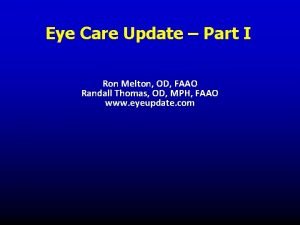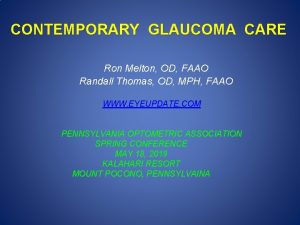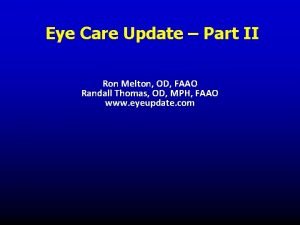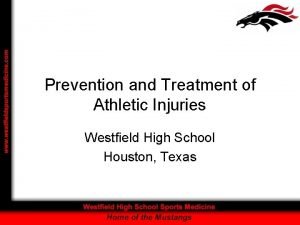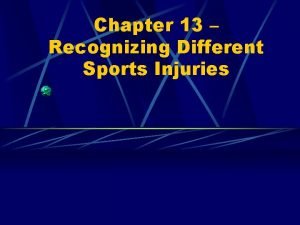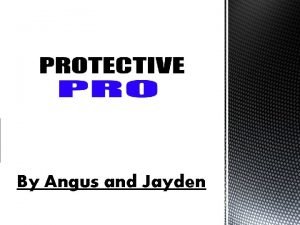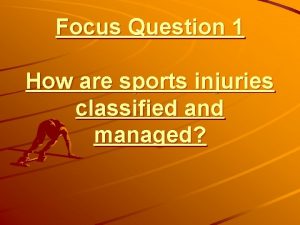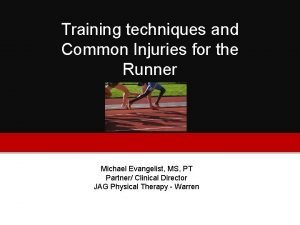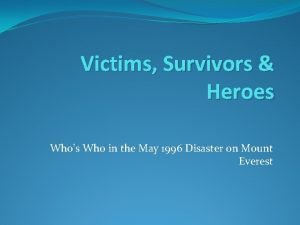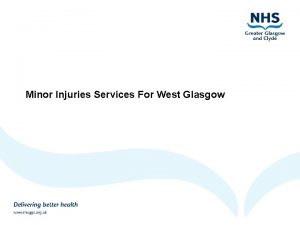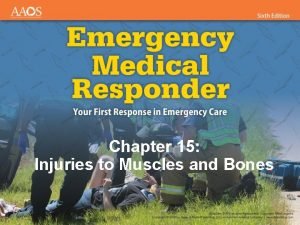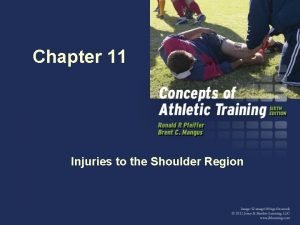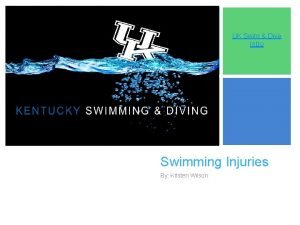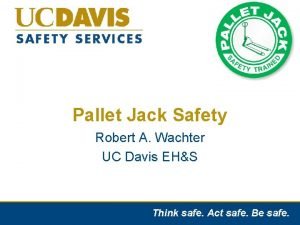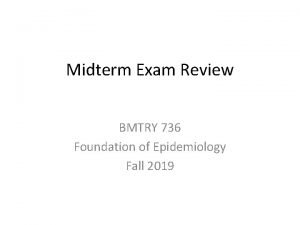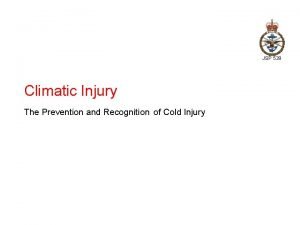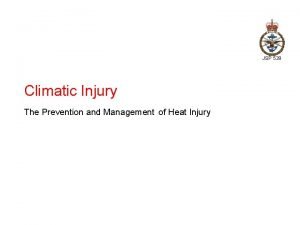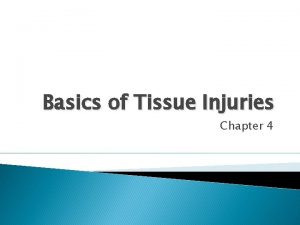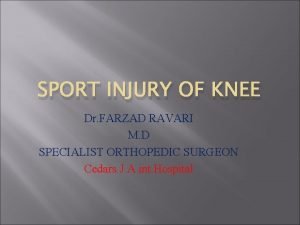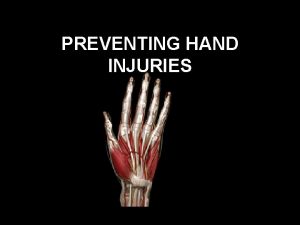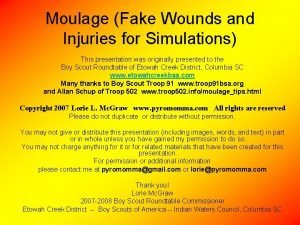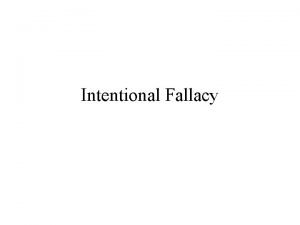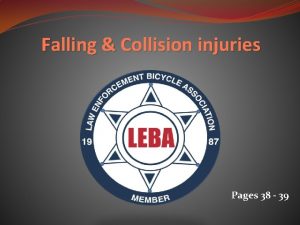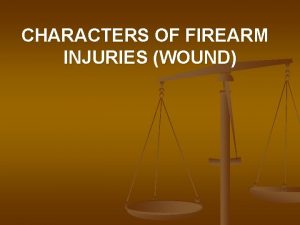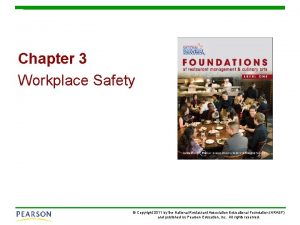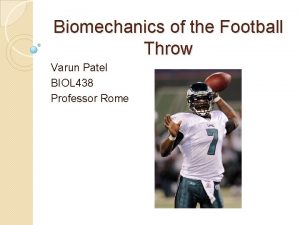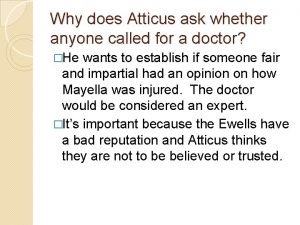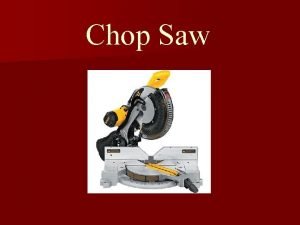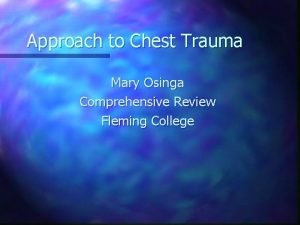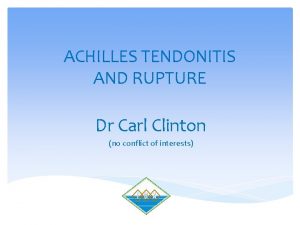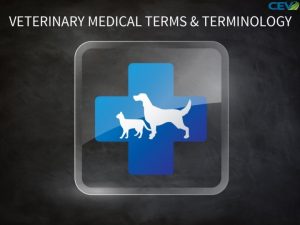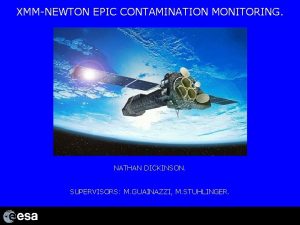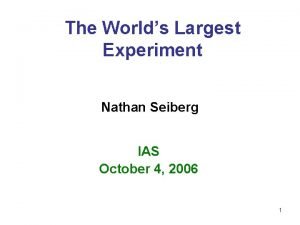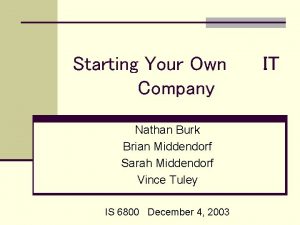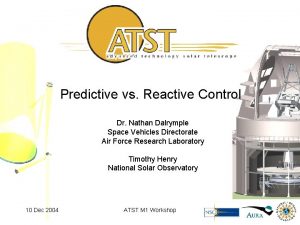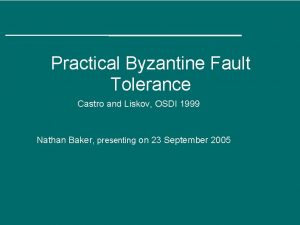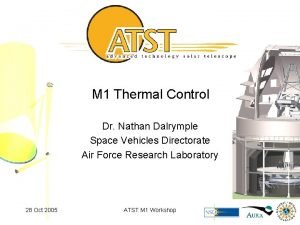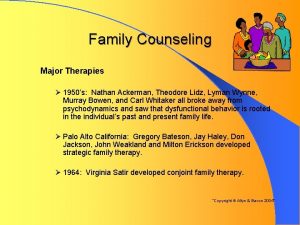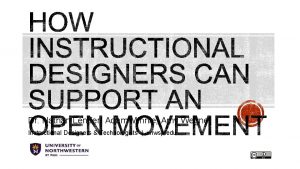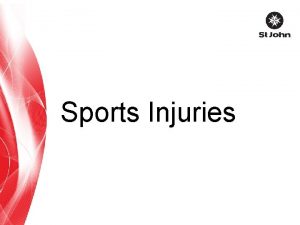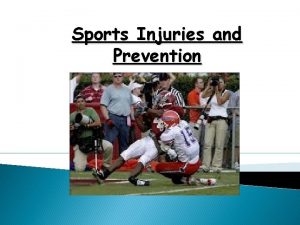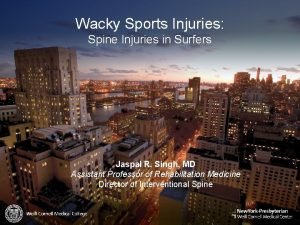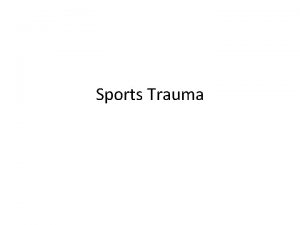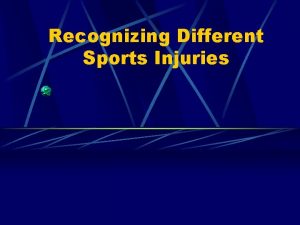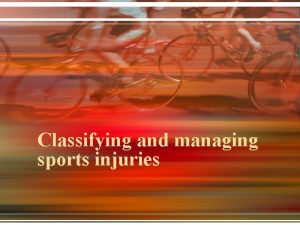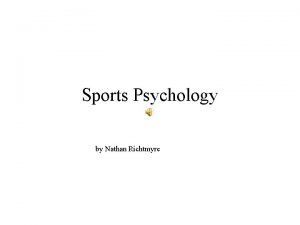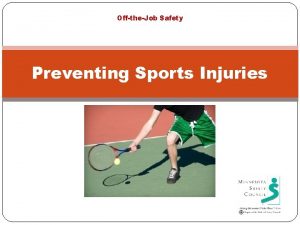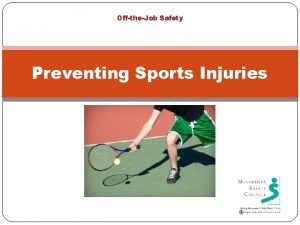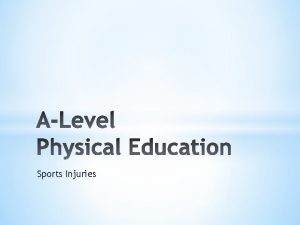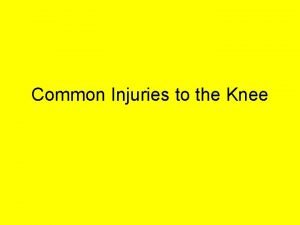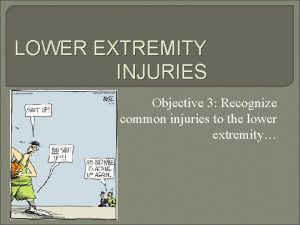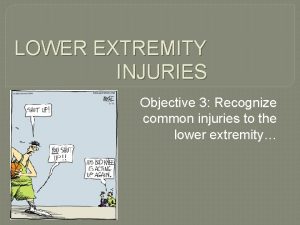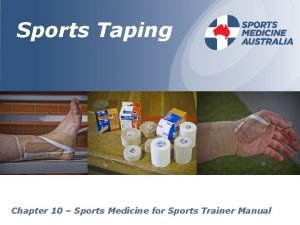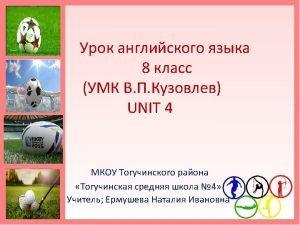Common Sports Injuries Nathan Melton D O Medical











































































- Slides: 75

Common Sports Injuries

Nathan Melton D. O. Medical School Residency: Grandview Hospital Fellowship

Team Physician

Team Physician

Cervical Spine Ø 11, 000 Catastrophic Cervical spine injuries per year Ø 7. 4 % are related to sports Ø Vast majority are football related

Cervical Spine ABC’s Ø Prevention of further injury Ø



Burners

Burners (Brachial Plexopathies) Ø Very common- 70% of college football players have experienced one Ø Method of injury- Usually due to movement of the head away from the shoulder (Stretching of the Nerves) or direct trauma Ø Presentation- Usually unable to move the involved extremity (numbness & weakness)

Burners (Brachial Plexopathies) Ø Grade I- neuropraxia with demyelination of the myelin sheath no axonal disruption l Complete recovery in minutes to days l

Burners (Brachial Plexopathies) Ø Grade II- axonotmesis disruption of the axon and myelin sheath with preservation of the peri, endo, epineurium l Regrows at 1 -7 mm a day l Weakness lasts for weeks but full recovery can be expected. l

Burners (Brachial Plexopathies) Ø Grade III- complete transection extremely rare l Surgery required for any recovery l

Burners (Brachial Plexopathies) Ø Treatment- thorough neuro exam consider AC separation, clavicle fracture, or shoulder dislocation in your differential Ø if symptoms clear in minutes and no neck pain, limitation of neck movement, or shoulder pain- Patient can return. Ø Examine after the game

Burners (Brachial Plexopathies) Ø if symptoms last for more than a few minutes- Xray and MRI to rule out compressive pathology Ø Happens on more than 1 occasion they need to be removed and C Spine Xrays obtained

Things to look for Ø Cervical point tenderness Ø Neck stiffness Ø Bony deformity Ø Fear of head movement Ø Heavy head complaints Ø Bilateral symptoms Ø Treat like a spinal injury- Spine board and C-spine immobilization

Shoulder Dislocation



Dislocations Ø Most commonly traumatic and anterior Ø Postion of vulnerability (Abduction/ER) Ø 70% recurrence rate in patients under 22 Ø Independent of length of immobilization and physical therapy Ø Usually have a Bankart lesion (detached labrum) Ø Correlation between number of dislocations and soft tissue injury

Hippocrates Technique You’re gonna do what?


ZZZZZZZ Stimson Technique Most commonly used on the field technique Patience and Relaxation are key Typically takes 10 -15 minutes

Bony Bankart








Acromioclaviclular Separation Ø Usually due to direct trauma- Superolateral aspect of the shoulder Ø Player striking the ground Ø the acromion is forced inferior relative to the clavicle


CLASSIFICATION Ø Type I AC ligament sprain l AC joint intact l CC ligament intact l Deltoid and Trapezius muscles intact l

CLASSIFICATION Ø Type II AC joint disrupted l CC ligament sprain l Deltoid and Trapezius intact l

CLASSIFICATION Ø Type III AC ligaments disrupted l AC joint dislocated l CC ligaments disrupted l Deltoid and Trapezius detached from distal clavicle l

CLASSIFICATION Ø Type IV AC/CC ligaments disrupted l Clavicle displaced posteriorly into or through Trapezius l

CLASSIFICATION Ø Type V AC/CC ligaments disrupted l Gross disparity btw clavicle and scapula l Deltoid and Trapezius detached from distal half of clavicle l

CLASSIFICATION Ø Type VI AC/CC ligaments disrupted l Clavicle displaced inferior to acromion or coracoid process l

DIAGNOSIS Ø History Ø Mechanism of Injury Ø Physical Exam Ø Radiographs



Nonoperative Treatment Type I and II l More than 35 different forms of management l Sling 10 -14 days, early and gradual PT l Heavy lifting and contact sports avoided for 8 -12 weeks l

Operative Treatment Ø Grade III +/-, in younger, active Ø Grade IV, V and VI patients



Pelvis, Hip, and Thigh

Pelvis, Hip, and Thigh Ø Soft tissue injuries • Hip pointer l injury includes apophyseal avulsions and fractures and contusions of the iliac crest • rest, ice, compression, elevation, NSAIDs, physical therapy

Knee Injuries

Knee Ø 20% of all football injuries l 42 ACL tears per 1000 players per year Ø skiing accounts for at least one ACL tear per day at major ski resorts

Collateral ligamentous Injuries

Collateral ligamentous Injuries

ACL Exam Lachman test

ACL/PCL exam

Knee

Knee Dislocations Ø Named by location of the tibia to the femur Ø Mechanisms-Anterior, Posterior, Medial and Lateral

Knee Dislocations EMERGENCY l Limb threatening injury due to the high incidence of vascular injuries associated (25 -30%) l neurologic injury 9 -49% l management • immediate closed reduction on the playing field, followed by splinting; orthopedic/vascular evaluation

Knee Dislocations Document neurovascular status Ø Reduce by pushing the tibia in the appropriate direction Ø After reduction immobilize at 20 -30 degrees of flexion with NO casting or dressing materials Ø Arteriogram vs ABI debate post reduction Ø If the artery is repaired a fasciotomy is often done Ø Also look for neurologic injury the peroneal nerve is injured 14 -35% of the time Ø

Knee Dislocations Ø Popliteal is at risk due to proximal and distal fixation. Collateral arteries can’t maintain flow and pulses don’t exclude injury. Ø Repair 8 hrs. after injury 86% amputation rate Ø Repair < 8 hrs. 80% salvage rate

Patellar Dislocations Ø Extend knee l l Medial directed pressure on patella Knee immobilizer, may WB in extension

Shin Splints

Shin Splints Ø Topical or Oral NSAIDs Ø Compression Sleeves Ø Achilles Stretching Ø Most Importantly make sure it improves with these measures

Stress Fracture • Bone Scan MRI


Stress Fractures Protected or Nonweightbearing Long Term Issues • • • Nutrition Hormonal Training

The Ankle Sprain Ø Most frequently injured structure in all of sports

ANATOMY

Ø ATFL- 40% of injuries Ø ATFL and CFL- 58% Ø ATFL, CFL and PTFL- 3% Ø Deltoid- vast majority are a midsubtance tear

DIAGNOSIS Ø History- Mechanism Ø Physical examination l l l Location of Pain- Palpation Anterior drawer Talar tilt

In the Acute Setting Ø Joint Injury l l l Ø Articular injury Syndesmotic strain Fracture Tendon injury l l l Peroneal Anterior Tibialis Achilles

Treatment Ø Vast Majority-Nonoperative Ø Boot, SLC, Ankle brace du jour Ø Gradual return to full activities Ø Proprioceptive exercise (PT) l l Wobble Board 1 legged stand (+/- pillow)

Turf Toe l hyperextension injury of the first MTP joint associated with play on artificial turf


Turf Toe MRI

Thank You! (937) 428 -0400 ask for Linda
 Ron melton od
Ron melton od Melton od tablet
Melton od tablet Od
Od Westfield sports injuries
Westfield sports injuries Chapter 11 assessment and evaluation of sports injuries
Chapter 11 assessment and evaluation of sports injuries Chapter 13 worksheet recognizing different sports injuries
Chapter 13 worksheet recognizing different sports injuries Sports injuries angus, on
Sports injuries angus, on How are sports injuries classified and managed
How are sports injuries classified and managed Common track and field injuries
Common track and field injuries Outdoor and indoor sports
Outdoor and indoor sports Yasuko namba
Yasuko namba Unit 15:3 providing first aid for bleeding and wounds
Unit 15:3 providing first aid for bleeding and wounds Hunger games chapter 13 questions and answers
Hunger games chapter 13 questions and answers Sentinel injuries
Sentinel injuries Victoria hospital glasgow minor injuries
Victoria hospital glasgow minor injuries When to use hammock carry
When to use hammock carry A short backboard or vest-style immobilization
A short backboard or vest-style immobilization Chapter 21 caring for head and spine injuries
Chapter 21 caring for head and spine injuries Chapter 17:1 providing first aid
Chapter 17:1 providing first aid Injuries to muscles and bones chapter 15
Injuries to muscles and bones chapter 15 Chapter 14:3 observing fire safety
Chapter 14:3 observing fire safety Jones and bartlett learning
Jones and bartlett learning Chapter 13:2 preventing accidents and injuries
Chapter 13:2 preventing accidents and injuries Chapter 11 injuries to the shoulder region
Chapter 11 injuries to the shoulder region Tnt swimming
Tnt swimming Uc davis web scheduler
Uc davis web scheduler The cause-specific mortality rate from roller-skating was:
The cause-specific mortality rate from roller-skating was: Climatic injuries
Climatic injuries Jsp 539
Jsp 539 Chapter 12 lesson 4 fitness safety and avoiding injuries
Chapter 12 lesson 4 fitness safety and avoiding injuries Chapter 4 preventing injuries through fitness
Chapter 4 preventing injuries through fitness Chapter 4 basics of tissue injuries
Chapter 4 basics of tissue injuries Bo taoshi injuries
Bo taoshi injuries Miniscal
Miniscal Preventing hand injuries
Preventing hand injuries How to protect yourself from intentional injuries
How to protect yourself from intentional injuries How to make fake skin with vaseline and cornstarch
How to make fake skin with vaseline and cornstarch Poem about intentional injuries
Poem about intentional injuries Injuries first aid
Injuries first aid Emergency care and first aid ppt
Emergency care and first aid ppt Injuries first aid
Injuries first aid Characters of firearm injuries
Characters of firearm injuries Which osha document summarizes occupational injuries
Which osha document summarizes occupational injuries Fundamentals of throwing a football
Fundamentals of throwing a football Who does atticus suggest beat mayella
Who does atticus suggest beat mayella Why do the hunger games start at 10am
Why do the hunger games start at 10am Chop saw injuries
Chop saw injuries Deadly dozen trauma
Deadly dozen trauma Carl clinton construction
Carl clinton construction Factors of 48 and 60
Factors of 48 and 60 Common anode and common cathode
Common anode and common cathode Prime factors of 72
Prime factors of 72 What are the factors for 54
What are the factors for 54 Common factors of 12 and 42
Common factors of 12 and 42 Multiples of 9 and 21
Multiples of 9 and 21 Tnt veterinary abbreviation
Tnt veterinary abbreviation California medical license for foreign medical graduates
California medical license for foreign medical graduates Greater baltimore medical center medical records
Greater baltimore medical center medical records Hepburn osteometric board
Hepburn osteometric board Torrance memorial human resources
Torrance memorial human resources Cartersville medical center medical records
Cartersville medical center medical records Nathan dickinson
Nathan dickinson Nathan barrios
Nathan barrios Nathan seiberg
Nathan seiberg Nathan brunelle
Nathan brunelle Brian middendorf
Brian middendorf Tami lynne tinning
Tami lynne tinning Nathan dalrymple
Nathan dalrymple Nathan liskov
Nathan liskov Nathan rinne
Nathan rinne Nathan dalrymple
Nathan dalrymple Nathan seiberg
Nathan seiberg Nathan ackerman family therapy
Nathan ackerman family therapy Dr wegner nathan
Dr wegner nathan Nathan weiss graduate college
Nathan weiss graduate college Glenn nathan
Glenn nathan
